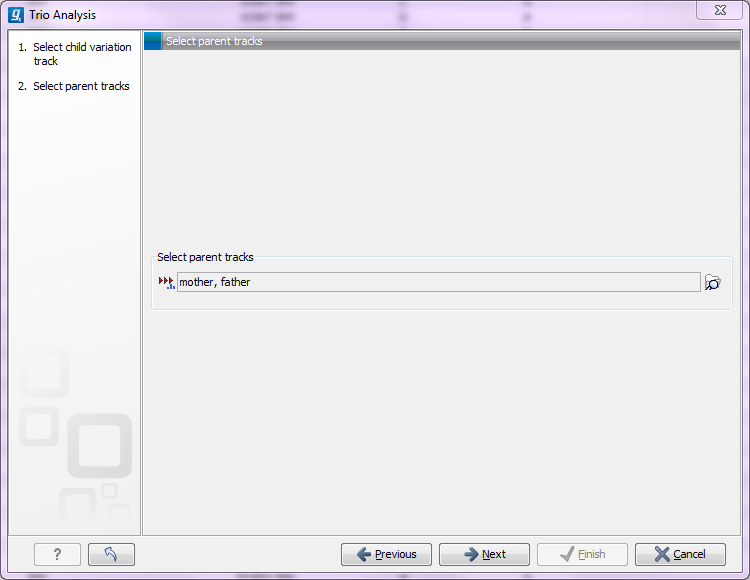Trio analysis
This tool should be used if you have a trio study with one child and its parents. It should be mainly used for investigating differences in the child in comparison to its parents.
Toolbox | Resequencing (![]() ) | Compare Variants | Trio Analysis
) | Compare Variants | Trio Analysis
In the first step of the dialog, you select the variant track of the child. Clicking Next shows the dialog in figure 26.26.

Figure 26.26: Selecting variant tracks of the parents.
Select (![]() ) the two variant tracks from the parents and click Next and Finish.
) the two variant tracks from the parents and click Next and Finish.
For each variant in the child, the tool will report if it is inherited from father, mother, both or is a de novo mutation. In case it is inherited from both parents it will also check for a potential 'accumulative' mutation. Accumulative mutations are present in heterozygote state in each of the parents, but are homozygote in the child. To investigate potential disease relevant variants, 'accumulative' variants and de novo variants are the most interesting (in case the parents are not affected). The tool will also add information about the genotype (homozygote or heterozygote) in all samples.
The following annotations will be added to the resulting child track:
- Zygosity
- Zygosity in the child as reported from the variant caller. Can be either homozygote or heterozygote.
- Zygosity (Name of parent track 1)
- Zygosity in the corresponding parent (e.g. father) as reported from the variant caller. Can be either homozygote or heterozygote.
- Allele variant (Name of parent track 1)
- Alleles called in the corresponding parent (e.g. father).
- Zygosity (Name of parent track 2)
- Zygosity in the corresponding parent (e.g. mother) as reported from the variant caller. Can be either homozygote or heterozygote.
- Allele variant (Name of parent track 2)
- Alleles called in the corresponding parent (e.g. mother).
- Inheritance
- Inheritance status. Can be one of the following values: 'De novo', 'Accumulative', 'Inherited from both', 'Inherited from (Name of parent track)'.
Please note: In case there is no variant found at this position in one or both of the parents the zygosity status is not known and the allele variant column has the value 'none'.
